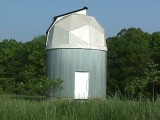The
case for an observatory...dome that is.
|
|
(the advantages
of observatories and domes in particular)
|
by
Doug Kniffen
 Every
amateur astronomer should have some sort of observatory. The reason
is time. Most people are so busy that it isn't possible to find
much more than an hour to do some observing. Even in an urban area
an observatory, with all necessary equipment ready for use, will
provide new opportunity to observe. Every
amateur astronomer should have some sort of observatory. The reason
is time. Most people are so busy that it isn't possible to find
much more than an hour to do some observing. Even in an urban area
an observatory, with all necessary equipment ready for use, will
provide new opportunity to observe.
There
are two primary advantages to a dome compared to other types of
personal observatories; environmental moderation and, consequently,
improved deep sky observing ability. The later benefit is the most
important. This particular dome advantage is realized through greater
dark adaptation. While obvious to the urban amateur, few observers
are aware that even the darkest rural sky will limit the degree
of your low light perceptive ability. The stars themselves will
prevent full dark adaptation. In a rural location, a dome will facilitate
observing extended objects a full magnitude fainter than possible
with the same instrument used in a run-off roof type structure.
The dark adaptation benefit would be greater at an urban site.
A
well designed dome will both moderate the wind and reduce nocturnal
dampness. Not all domes adequately accomplish these two tasks. Since
I have not had the opportunity to observe within one of the newer
plastic domes, some of the succeeding comments may not be relevant
when applied to this type of material.
If
thermal equilibrium, with ambient conditions, is achieved then metal
domes can become uncomfortably damp and cold, especially on nights
with little or no wind. Despite the maintenance and longevity considerations,
wood is arguably a superior choice of material for amateur domes.
The personal comfort factor may be the most important, but the drastically
lower cost of material and requisite tools should not be easily
dismissed. My whole observatory (pictured) project cost less than
$2000 dollars over the winter of 1992/93.
Most
small observatory buildings, not just domes, are not well designed
regarding ventilation. If inadequate airflow is a problem, both
temperature and humidity will become higher than the outside air
during the day. In addition to the potential problems of perpetually
damp equipment, it may take many hours to cool off the building
at night. Such local disturbances to seeing don't impair visual
observation very much, but they may become important if imaging
celestial objects. My dome was deliberately designed to provide
adequate ventilation. Only rarely does the temperature difference
exceed 4 degrees and, despite wood construction, the relative humidity
difference doesn't vary by more 6% between the inside and outside
of the building. Several times per year (very hot very humid days
with absolutely no wind) I use electric fans to help cool the building
at night.
With
adequate ventilation, the building will be drafty, but wind is moderated.
In my observatory, any breeze less than 5 mph will pass through
relatively unimpeded. When outside wind speed exceeds 50 mph the
draft inside is strong enough (10 to 12 mph) to blow papers off
the desk and across the floor (the dome may also turn in the wind
above 50mph).
Finally,
local non-thermal turbulence can be caused by wind velocity. With
an obstruction to airflow, such as a wall or dome, there is always
a change in velocity relative to unobstructed air flowing nearby.
This change will create swirls, eddies and shear layers that distort
light passing through them. The higher the difference in flow velocity
across a given area, the greater the distortion. A dome will cause
less turbulence than a wall (run-off roof) at most wind speeds.
There does exist a difference between domes at relatively high wind
speeds. Informal experiments with scale models demonstrated the
advantages of using a first level geodesically expanded dodecahedron.
A conventional smooth dome will generate strong shear down wind
due to the even acceleration around the dome. My particular dome
was designed with a simplified geodesic expansion method that I
developed (I removed 95% of the math, and 99% of the confusion compared
to the original geodesic design method). An expanded dodecahedron
offers an improvement over a conventional dome regarding turbulence
caused by the building. This shape of the dome is round enough that
it doesn't act like a sail, and pointed enough that it doesn't create
as much lift as a smoother dome.
Doug
Kniffen
<back
to articles>
|